The arrival of the Obama administration provides Marine Corps Generals with the excuse they need to save face and dump the failed V-22 Osprey program "because of budget cuts." This is critical because the V-22 has demonstrated less than half the range and payload promised, while readiness rates are worse than the Corps' decades old helicopters. (V-22s leak so much oil that they must be refilled prior to each mission.) The Marine Corps has received over 100 V-22s, yet fewer than 80 are in operational service due to varied technical failures, like frequent engine fires that ignite its flammable composite skin.
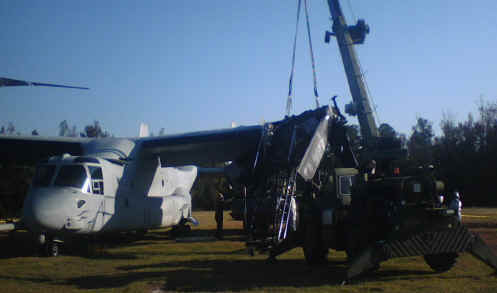
Marine aviation now faces a crisis as ground forces shift to mountainous Afghanistan. The V-22's smaller proprotors limit vertical performance at higher altitudes. It cannot pick-up or deliver any useful payload vertically above 6000 feet, so it will be limited to airplane operations. However, the Corps is phasing out its CH-46Es and quickly losing much of its vertical lift capability. Here is the Corps' FY 2009 Aviation Plan (pdf) for those interested.
The V-22 is Not Shipboard Compatible
Despite the sales pitch about its revolutionary amphibious reach, the Corps has yet to deploy V-22s aboard Navy ships, although those sent to Iraq were transported aboard ship rather than using their falsely advertised capability to self-deploy overseas. The first shipboard deployment was planned for November 2008 with VMM-266 attached to the 26th MEU for a Persian Gulf deployment aboard the USS Iwo Jima. Serious problems developed during shipboard training just prior to the deployment and the idea was scrapped. HMM-264 with its CH-46Es was called upon to deploy with the 26th MEU while VMM-266 Marines were flown to Iraq to fly V-22s between large airbases.
A stealthy cover-up ensued to hide this failure. News releases from several units had described VMM-266's pre-deployment training with the 26th MEU. These were deleted from websites, although one copy remains posted at the private Marine Corps Aviation Association. "Ready to Go Fast" describes VMM-266's pre-deployment training for the historic first shipboard deployment of the V-22. Facts about HMM-264's sudden shipboard deployment cannot be located, and its website has disappeared.
(March 10, 2009 update: That link disappeared a couple weeks after I linked it. All a coincidence I'm sure. Having experienced such actions in the past, I made a copy which can be read here: "Ready to Go Fast" I now ask concerned Marine Aviators to contact their association leaders and inquire why they removed that Marine Corps public relations release. Are they conspiring to cover up failures too?)
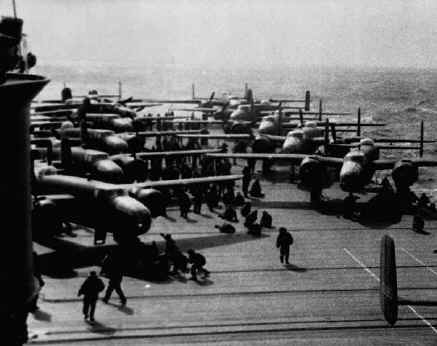 As
a result, most Marine Generals now know
that the V-22 is not shipboard compatible.
This was no surprise to senior V-22 managers since unsolvable problems were identified
years ago. V-22s are shipboard capable, meaning
that they can operate from ships, but not in a practical sense. The B-25s used
in the Doolittle raid on Tokyo (pictured) during World War II proved capable of flying off
ships. but they weren't compatible for routine shipboard operations.
As
a result, most Marine Generals now know
that the V-22 is not shipboard compatible.
This was no surprise to senior V-22 managers since unsolvable problems were identified
years ago. V-22s are shipboard capable, meaning
that they can operate from ships, but not in a practical sense. The B-25s used
in the Doolittle raid on Tokyo (pictured) during World War II proved capable of flying off
ships. but they weren't compatible for routine shipboard operations.
The B-25 was much smaller than the V-22, yet it could carry a bigger payload twice as far. It also carried twelve 12.7mm machine guns for self-defense, whereas the V-22 only has one 7.62mm on the back ramp. A tiltrotor can fly like an airplane or a helicopter, yet the compromise design limits its performance to less than half of either platform. Read G2mil's Why Tiltrotors Fail for a quick answer. More details on why conventional helicopters are a better choice for vertical lift can be read in a new book "Helicopters - Thinking Forward, Looking Back" by one of America's top rotorcraft experts, Dr. J. Gordon Leishman, of the University of Maryland.
Commitment to Failure
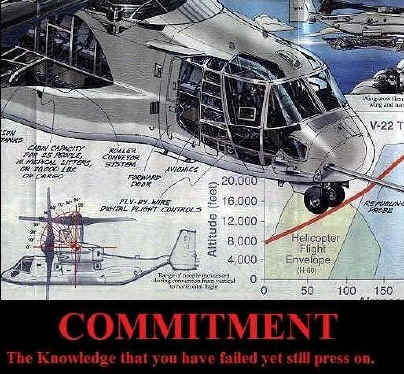 The senior people involved in the V-22 program
have known this aircraft is not shipboard compatible for over a decade. An
insider circulated an image describing the Corps' mad effort to field 360
V-22's. (pictured) One
problem is that with rotors up and engines running, the V-22's turbojet engines
blow hot exhaust directly on the deck. This burns away the
"no-skid" surface and after a few minutes the metal deck warps and
sinks several inches. The hazard to nearby personnel is obvious, and poses
problems below deck as spaces heat up forcing sailors to flee.
The senior people involved in the V-22 program
have known this aircraft is not shipboard compatible for over a decade. An
insider circulated an image describing the Corps' mad effort to field 360
V-22's. (pictured) One
problem is that with rotors up and engines running, the V-22's turbojet engines
blow hot exhaust directly on the deck. This burns away the
"no-skid" surface and after a few minutes the metal deck warps and
sinks several inches. The hazard to nearby personnel is obvious, and poses
problems below deck as spaces heat up forcing sailors to flee.
There is no solution to this problem, other than limiting flight operations so that V-22s never sit at one place with engines running for more than a couple of minutes. Those familiar with the complexities of launching and sustaining a ships' 30+ aircraft during amphibious operations know this is impossible.
The second problem is that the V-22 must be unfolded to perform engine maintenance. It is so big that only one V-22 can be unfolded in the hangar below deck, which blocks the movement of other aircraft. The weak solution is a demand bigger ships, yet the amphibious flattops today are bigger than World War II carriers. In addition, the first of a new class of 12 ships couldn't enter the fleet until most V-22's reach retirement age.
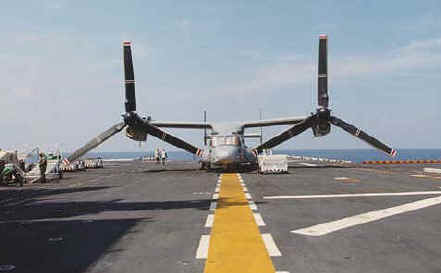 The temporary solution is to perform V-22 maintenance
topside. This is far more difficult due to winds and weather, and restricts
flight deck use. Moreover, the four big CH-53s that normally deploy with each
amphibious flattop do their maintenance topside, so there is no room for V-22s.
Finally, V-22s require much unique maintenance equipment that crowds ship spaces.
All Marine Generals know about this problem because a brave
Marine Captain wrote an article that appeared in the
"Marine Corps Gazette" two years ago. The author boldly suggested
that V-22s remain ashore and only helicopters deploy aboard ship.
The temporary solution is to perform V-22 maintenance
topside. This is far more difficult due to winds and weather, and restricts
flight deck use. Moreover, the four big CH-53s that normally deploy with each
amphibious flattop do their maintenance topside, so there is no room for V-22s.
Finally, V-22s require much unique maintenance equipment that crowds ship spaces.
All Marine Generals know about this problem because a brave
Marine Captain wrote an article that appeared in the
"Marine Corps Gazette" two years ago. The author boldly suggested
that V-22s remain ashore and only helicopters deploy aboard ship.
The third problem is the V-22's side-by-side rotors require several more feet of deck clearance than even the big CH-53s. As a result, they must land just five feet from the edge of the ship. There is ongoing debate if it safe to land V-22s on deck spots near the ship's island; i.e. the large ship structure that rises above the flight deck. This can be done, but given the limited clearance and the odd airflows on a pitching deck, most pilots dislike the idea. The fourth problem involves several safety related issues, as described here: Why the V-22 is Still Unsafe That article discusses the HIGE/HOGE rotor imbalance danger that helicopter pilots recognize in the picture below.
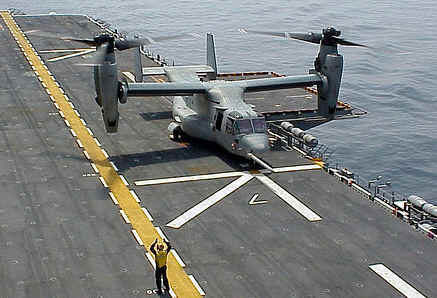 A
report on the V-22 sea trials by V-22 test pilot LtCol John Rudzis
mentions this danger that he encountered back in 1999: "A
left seat landing under relative winds over deck of 355 deg relative and
twenty-five knots resulted in a roll excursion of thirty-seven degrees angle
of bank while only ten feet above the deck level. Only that the left rotor was
over the water and full power had been applied to initiate a climb, prevented
the nacelle or rotor from impacting the ship. Further testing in these
conditions was suspended until this event could be thoroughly
investigated."
A
report on the V-22 sea trials by V-22 test pilot LtCol John Rudzis
mentions this danger that he encountered back in 1999: "A
left seat landing under relative winds over deck of 355 deg relative and
twenty-five knots resulted in a roll excursion of thirty-seven degrees angle
of bank while only ten feet above the deck level. Only that the left rotor was
over the water and full power had been applied to initiate a climb, prevented
the nacelle or rotor from impacting the ship. Further testing in these
conditions was suspended until this event could be thoroughly
investigated."
Another danger issue is that downwash from nearby flying helicopters or other V-22s can push down on a wing of a stationary V-22 causing it to smash the engine on deck, or possibly roll it off the side. Downwash can also blow out good air from under one rotor of a hovering V-22, but not the other, causing an instant roll. This is why V-22s have a 250 ft. separation requirement between aircraft. This is no problem at airbases, but is an extreme limitation on a flight deck or landing zone. A 2002 NAVAIR study (pdf) by Kurt Long warned that these problems "could prohibit ALL shipboard ops." This is why most of the planned hours of shipboard testing during the 2005 OPEVAL were cancelled.
The V-22 is Bigger than the CH-53E
The V-22 weighs more than the big CH-53E, which can carry twice as much. The V-22 is a heavyweight class rotorcraft with poor medium-lift performance. The V-22 can perform a contortionist routine to fold up on ship, but that saves only physical space. Ships can only carry so much weight before they become unstable. This is particularly important for objects high on ship, like on the flight deck. As a result, some Marine Generals recently discovered that twelve V-22s cannot deploy aboard ship with a standard MEU composite squadron.
The traditional Air Combat Element (ACE) embarked aboard an LHD or LHA class (big Navy flattop amphibious ship shown below) this past decade is 12 CH-46Es, 4 CH-53Es, 6 AH-1Ws, 3 UH-1Ns, and 6 AV-8Bs. This is considered the ideal mix for likely missions, and the maximum that can effectively operate due to complexities of refueling, spotting, recovering, folding, and moving aircraft around. This mix varies and fewer have been deployed in recent years due to the war in Iraq and helicopter shortages caused by delays with the V-22 program.
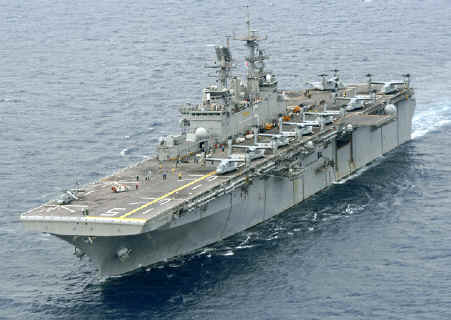 Assuming that
a V-22 can safely operate from ship, it is twice the weight of a CH-46E, so deploying
12 V-22s as the backbone of a traditional ACE is not feasible. The similar-sized
CH-53E has deployed as the primary ACE squadron, but with only 8 CH-53Es. The squadron that briefly deployed aboard ship for the 2005 OPEVAL
consisted of just 8 V-22s, with few other aircraft. (pictured) In the OPEVAL
report, it was
politely noted that operating 12 V-22s as part of an ACE would be "a challenge."
Assuming that
a V-22 can safely operate from ship, it is twice the weight of a CH-46E, so deploying
12 V-22s as the backbone of a traditional ACE is not feasible. The similar-sized
CH-53E has deployed as the primary ACE squadron, but with only 8 CH-53Es. The squadron that briefly deployed aboard ship for the 2005 OPEVAL
consisted of just 8 V-22s, with few other aircraft. (pictured) In the OPEVAL
report, it was
politely noted that operating 12 V-22s as part of an ACE would be "a challenge."
It is not practical to operate an ACE with 12 big V-22s and 4 big CH-53Es along with other aircraft. It is possible to cram more aircraft on a ship, but many would remain folded in the hangar deck during high-tempo operations. In addition, sustaining V-22 operations are more time consuming since its best for them to land on the few spots far from the island, maintenance must be done topside, and they consume twice as much fuel as CH-46Es so they take twice as long to refuel. Finally, their engines heat up the deck while the Navy "deck boss" must maximize aircraft separation. Finally, V-22s take longer to fold and unfold since the wing must pivot.
On the basis of empty weight, it is fair count 6 V-22s equal to the shipboard use of 12 CH-46Es. As a result, a typical V-22 based ACE will consist of 6 V-22s, 4 CH-53Es, 6 AH-1Ws, 3 UH-1Ns, and 6 AV-8Bs. To hide this embarrassment, perhaps 10 V-22s will deploy with the first ACE so fewer helicopters will be embarked, or a few V-22s will remain folded and stored in the hangar deck. All this assumes that Navy ship captains allow the extra weight aboard, and that continual deck warping does not result in serious structural problems with the flight deck. Note the much smaller MH-60S on the bow of the ship above, which can lift the same payload vertically as a V-22 because it has big, flat rotors.
Superior Alternatives
The V-22's high cost and poor performance is defended by claiming the Corps has no good alternatives. Comedian Oliver North recently commented at Fox News that if the V-22 was cancelled, "Marines will have to walk to the next war." Bell-Boeing's public relations team handles this issue by claiming the only medium-lift alternatives are the S-92 and UH-101, and because those are not in U.S. military service it would take years and billions of dollars of test and development before any could be fielded. This misdirection ruse deters attention from superior alternatives.
The Marine Corps has several options to purchase modern helicopters now in production and in service with the U.S. military. These cost half as much to procure and operate, yet can more than double the vertical lift of what V-22s can provide. The current fleet of V-22s can continue the niche they found by flying like an airplane between airbases, but helicopters are needed to fill the vertical medium-lift mission on ships and in combat zones. Here is a detailed chart of alternatives:
| Aircraft | Empty Weight | Combat Troops |
Cruise Speed |
Max Payload 50nm to LZ | FY09 Flyaway Cost1 |
| UH-1Y | 11,837 lbs | 9 | 135 knots | 6,000 lbs | $23.7 million |
| MH-60S2 | 11,516 lbs | 12 | 150 knots | 7,000 lbs | $30.6 million |
| CH-47F | 24,000 lbs | 33 | 155 knots | 16,000 lbs | $33.8 million3 |
| CH-53K | 35,000 lbs | 55 | 170 knots | 31,000 lbs | in development |
| MV-22B4 | 36,500 lbs | 145 | 210 knots | 6,000 lbs | $75.3 million |
| C-27J6 | 39,500 lbs | 46 | 305 knots | 25,320 lbs | $37.3 million |
1 Unit "fly away" cost excludes research, development, evaluation, and testing costs. These figures are based on DoD documents for the FY2009 budget. FY09 Procurement Programs (P-1) The V-22 program has always lied about unit cost, read V-22 Costs Soar.
2 The Navy MH-60S Knighthawk can also serve as an attack helo with miniguns and Hellfire missiles. The Navy wisely dropped plans for 48 HV-22s for vertrep ops in 2002, in favor of the MH-60S. Two decades ago, Navy secretary and former Marine infantry officer James Webb opposed the V-22, saying it was too big and too expensive to land in a combat LZ. He preferred dumping medium-lift for a "high-low" mix of H-60s and H-53s. This option is viable today, and the MH-60S price will drop if the Marines place an order. For example, the Army's Blackhawks cost just $16.3 million each in FY2009.
3 The actual unit cost for CH-47Fs in the FY2009 budget is $29.8 million each. However, most are older CH-47Ds that will be remanufactured. They reuse the airframe and some parts, saving around $7 million per aircraft. The Army did not specify the mix of remans and new-builds, so the figure in the chart is $4 million higher to approximate the cost of a new-build. The SpecOps MH-47 and USAF HH-47 variants are shipboard compatible. The CH-47F and CH-53K can carry two HMMWVs internally, whereas even an old jeep cannot fit in the V-22's small cabin.
4 This is the MV-22B "Block C" that includes all the "Block B" items left off for the 2005 OPEVAL to improve performance. Additional weight will soon be added with an airborne countermeasures system and a belly gun that will add another 1000 lbs in empty weight as reflected in this chart. The V-22 can take-off with more fuel and payload by rolling down a runway like an airplane, but so can helicopters. Since the V-22 is a helicopter replacement, its performance is best measured by what it can lift vertically, as specified in its acquisition contract. Performance specifications listed by the V-22 program and the Marine Corps on their websites are old goals that were never met, something the V-22 program public relations officer admits.
5The V-22 cabin is almost four feet shorter than the CH-46E, to cut empty weight. After I noted this several years ago, the V-22 program pencil whipped their website and handouts to match the CH-46E. Boeing's website still lists the true size: Length, max, ft (m) -- 20.8 (6.34); Width, max, ft (m) -- 5.7 (1.74); Height, max, ft (m) -- 5.5 (1.67). Nevertheless, contractors insist the V-22 can carry 24 combat equipped Marines, even after the GAO determined that only 15-18 Marines fit. To fit the planned belly gun in the hellhole, four seats will be removed for a remote crew station to aim and fire the gun.
6The C-27J is a new two-engine STOL military transport airplane that uses the same two engines as the V-22. It shows how poorly the V-22 performs as an airplane, mostly because it has small, fat wings and huge proprotors. The C-27J has three times more wing surface that provides three times more lift. The C-27J payload listed in the chart can be carried well past 50nm, out to 500nm.
The Simple MEU-ACE Solution - 8 CH-53K, 9 UH-1Y, 6 AH-1Z, 6 F-35BsThis option cancels more V-22s to simply buy more CH-53Ks, which are in development and expected to enter the fleet in 2015. These are the same size as the V-22, will cost half as much, are twice as safe, and twice as reliable because they are far less complex. They will have greater range and FIVE times the payload. These capabilities have yet to be proven, but this helicopter is based on a proven design (the CH-53E) with newer proven components. The Kilo's cabin is 11-inches wider than the old Echo's, so it can embark HMMWVs internally.
One problem is that production will not begin for a few years,
but this allows time to solve another problem. The CH-53s (and V-22s)
are too large for many missions. They require a large landing area and their
downwash can knock down tents, huts, and shacks. Moreover, many missions
lift small payloads, like an injured or sick Marine. Employing
big aircraft for such missions is very costly per hour and wastes tremendous
fuel. An article in the
Nov 2007 "Marine Corps Gazette" suggested that
another medium-lift helicopter is needed for such missions. 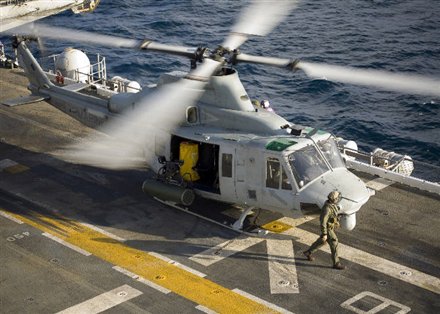
Smaller helicopters are more agile and can offload troops much faster than big aircraft with rear ramps, which can take over two minutes to disembark troops. In contrast, small Hueys don't even have to land if under fire since troops can leap out while the helicopter slows, as shown in the movie "We Were Soldiers Once."
The simple solution is to buy more UH-1Ys. (pictured) In fact, the Corps recently recognized this shortfall and increased the planned buy from 100 to 123. The "Yankee" is a major upgrade over the current UH-1N and is now in full production. Therefore, funds planned for the V-22 can be devoted to more UH-1Ys. Since this is produced by Bell Helicopter, it can move workers from V-22 production to UH-1Y production. The V-22 would remain confined to land-based missions, while CH-53s and UH-1s deploy on ship.
Current MEU-ACE - 12 CH-46E, 4 CH-53E, 3 UH-1N, 6 AH-1W, 6 AV-8B
Planned MEU-ACE - 6 MV-22B, 4 CH-53K, 3 UH-1Y, 6 AH-1Z, 6 F-35B-(JSF)
Simple Solution - 8 CH-53K, 9 UH-1Y, 6 AH-1Z, 6 F-35B
The Marines plan to have 12 V-22s with each MEU-ACE, but as discussed above, the V-22 is more than twice the size of a CH-46E and far more difficult to operate from a ship. Deleting the V-22 from the MEU-ACE in favor of more CH-53Ks and UH-1Ys can provide MEUs with DOUBLE the aerial lift of the current plan. An added advantage is that it eliminates an entire type of aircraft aboard ship, which greatly simplifies logistics and manning.
(Author note: The remainder of this article is complex and only discusses other alternatives that the Marine Corps is unlikely to adopt. It is not recommended for casual or busy readers.)
The Enhanced Solution - 8 CH-53K, 7 UH-1Y, 1 UH-60Q, 1 EH-60, 6 AH-1Z, 6 F-35B
This plan would increase the number of CH-53K and UH-1Y buys, but also add new capabilities by adding two proven Army H-60 types that the Corps really needs. The Marines never purchased a helicopter equipped as an air ambulance, like the Army's UH-60Q. This is desperately needed in counterinsurgency ops where minimizing deaths is politically important. Marines often call for Army UH-60Qs in Iraq for medivacs. In addition, the Marines never fielded an electronic warfare helicopter like the Army EH-60s. The Corps' ancient EA-6Bs focus on deep strike and are scheduled to be phased out in the next few years.
Since the Army already developed H-60 variants for medivac and electronic warfare, the Corps can just buy into the ongoing Navy MH-60 program to form an EH-60 and UH-60Q squadron on each coast. These Army systems are two decades old and due upgrades, so a joint Army/Marine program is best. The Navy would support this idea because it lacks these capabilities and may join in the buy. Attempting to customize, test, and develop these systems into the UH-1Y may prove too costly.
The H-60 Solution - 8 CH-53K, 7 MH-60S, 1 UH-60Q, 1 EH-60E, 6 AH-1Z, 6 F-35B
If the Corps proceeds with the previous option, it might as well buy the new Navy MH-60S "Knighthawk" for shipboard use and end the UH-1Y program, since Hueys are no longer used by any other service. The Army and Navy have thousands of H-60s in service, and H-60 parts and support are available from every Army/Navy heliport and Navy ship around the world, and from dozens of allies. Since these helicopters can carry side door guns and Hellfire missiles, they can serve as attack helos as well. External fuel tanks may be attached to H-60s when extended range is desired. The H-60s have wheels, so they are much easier to move around ship than UH-1s with skids. A final advantage is that H-60s easily slide into a C-17 for aerial transport, whereas V-22s cannot fit.
The Marine Corps already operates 8 VH-60Ds in the Presidential helicopter squadron. As part of a deal to cancel the V-22 to save "naval aviation" money, the Navy may agree to give to the Marines priority in the delivery of MH-60Ss that are in production today. Once production has ramped up, deliveries to the Navy could resume. Meanwhile, the Corps could immediately receive several new MH-60S each month to replace CH-46Es.
The H-60 Plus Solution - 8 CH-53K, 12 AMH-60S, 1 CH-60K, 1 UH-60Q, 1 EH-60E, 6 F-35B
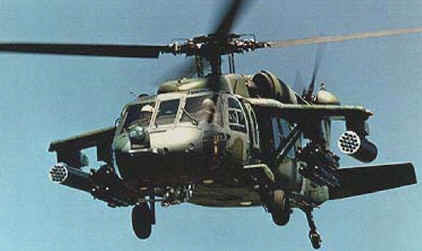 An option after adopting the MH-60S is to phase out the AH-1 Cobras in favor of
AH-60s. This eliminates yet another aircraft type and allows tremendous flexibility
since commanders can convert an MH-60S into an AH-60 (pictured) within an hour by adding Hellfire
missiles or rocket launchers, armor plates, and a ballistic floor mat. This
would provide an ACE with
the ability to launch 12 attack helicopters, or 12 transport helicopters, or
whatever combination desired. Yet another option is for the Marines to order
a few long-range CH-60K variants used by the Special Operations command, which have larger
fuel tanks and a fixed probe for in-flight
refueling.
An option after adopting the MH-60S is to phase out the AH-1 Cobras in favor of
AH-60s. This eliminates yet another aircraft type and allows tremendous flexibility
since commanders can convert an MH-60S into an AH-60 (pictured) within an hour by adding Hellfire
missiles or rocket launchers, armor plates, and a ballistic floor mat. This
would provide an ACE with
the ability to launch 12 attack helicopters, or 12 transport helicopters, or
whatever combination desired. Yet another option is for the Marines to order
a few long-range CH-60K variants used by the Special Operations command, which have larger
fuel tanks and a fixed probe for in-flight
refueling.
The H-47 Solution - 12 CH-47Fs, 1 HH-47Q, 1 EH-47, 3 UH-1Y, 6 AH-1Z, 6 F-35B
Sikorsky loves the H-60 options, but it would be more effective to cancel the CH-53K now in development and buy a navalized variant of the CH-47F, now in production for the U.S. Army. Boeing recently produced a navalized CH-47E for the Special Operations Command, which has folding rotors and saltwater resistant components, so no additional R&D is required. Boeing could use the facilities and workers now devoted to building the V-22's fuselage to double production of the CH-47F for the Marines.
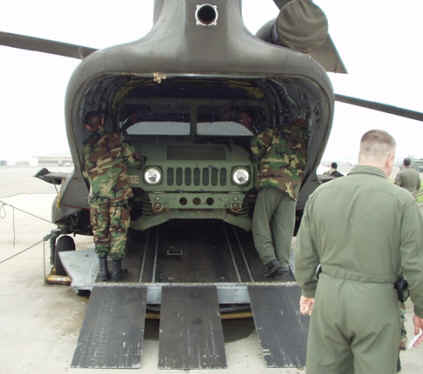 These could be delivered
sooner than the CH-53Ks and operational costs would be lower since parts are
produced for over a thousand CH-47s now in use by the U.S. Army, National Guard, two
dozen allied nations, and soon the U.S. Air Force. The Air Force recently awarded
Boeing a contract for 144 HH-47s after
it won competitive selection for its future CSAR platform. Boeing didn't bother to enter the
CV-22 in the
competition
because it was clearly inferior to its HH-47 candidate. The CH-47F can lift
twice as much as the V-22 and has greater range, yet costs half as much.
These could be delivered
sooner than the CH-53Ks and operational costs would be lower since parts are
produced for over a thousand CH-47s now in use by the U.S. Army, National Guard, two
dozen allied nations, and soon the U.S. Air Force. The Air Force recently awarded
Boeing a contract for 144 HH-47s after
it won competitive selection for its future CSAR platform. Boeing didn't bother to enter the
CV-22 in the
competition
because it was clearly inferior to its HH-47 candidate. The CH-47F can lift
twice as much as the V-22 and has greater range, yet costs half as much.
Two HMMWVs can fit inside a CH-47 while one old Jeep is too big for the V-22's small cabin, yet the V-22's empty weight is 50% more than the CH-47! Keep in mind that the new F variant can lift more than the Corps' 20-year old CH-53Es. The ability of a MEU ACE with 12 CH-47Fs to simultaneously lift a two dozen HMMWVs internally would be a massive leap forward.
The new Air Force variant is equipped with a hospital bed module, so the Corps may buy some HH-47Qs to fill its medivac gap. The Army operates CH-47Fs and its EH-60s are aging. Since electronic warriors always want more space for operators and gear, the Army may agree to a joint EH-47 development program. Otherwise, the Corps may develop its own EH-47s using the crews and some gear stripped from its 20 retiring EA-6Bs.
The C-2 Option
One reason the V-22 appealed to the Marines was its promise of greater speed and range. The expected cruise speed of 300 knots has become 210 knots, which is still better than the 150 knots of helicopters. However, its range is no greater than modern helicopters its size, and payload capacity is pathetic. The Marines could use some C-27J STOL airplanes that the Army and Air Force are buying. These are the same size as the V-22 and use the same engines, but with a pure airplane design that provides 50% more speed, twice more payload, three times more range, half the cost, and a cargo bay big enough for 46 troops or two HMMWVs. (see chart far above) The C-27J fills the gap when a C-130 is too big to move a small load. It is also faster and far less expensive to operate than a big helicopter.
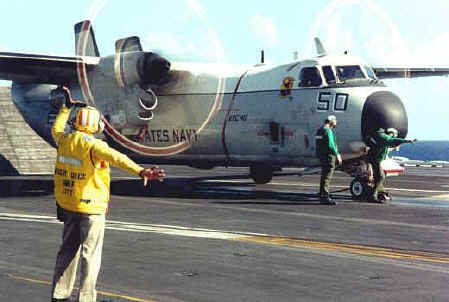 However,
with both the Army and Air Force buying the C-27J, a Marine buy looks like roles and
missions overlap. The Corps prefers to field unique capabilities tied to its
naval mission. The solution is an upgraded Navy C-2 carrier cargo aircraft (pictured), which
is nearly the same size as the C-27J. These are a couple decades old, but a
newer version is in production as the EC-2D Hawkeye, with a big radar dome atop.
However,
with both the Army and Air Force buying the C-27J, a Marine buy looks like roles and
missions overlap. The Corps prefers to field unique capabilities tied to its
naval mission. The solution is an upgraded Navy C-2 carrier cargo aircraft (pictured), which
is nearly the same size as the C-27J. These are a couple decades old, but a
newer version is in production as the EC-2D Hawkeye, with a big radar dome atop.
As EC-2D production ends in a few years, the Navy will produce an upgraded C-2, which support its aircraft carriers by flying loads from land bases. The Marine Corps can join in this buy of C-2s and field a few squadrons that would add great sustainability to Marine forces ashore. An upgraded C-2 should have a fatter C-27J-type fuselage to carry bigger cargo like a HMMWV.
Navy aircraft carriers are always near areas of conflict, but their value is limited in low intensity operations. However, Marine C-2s could fly casualties or civilian evacuees out to aircraft carriers, then load fuel, food, water, and medical supplies and return to the battlefield. The Marines could order a KC-2 variant to aerial refuel helicopters and vehicles far inland. KC-130s perform this mission today, but they need a large friendly airbase within range, and cannot land on aircraft carriers to obtain direct Navy support.
The Marines recently expressed interest in the AC-130 gunship used by Special Operations forces, who recently developed an AC-27J version. The Marines would find great value in an AC-2 gunship variant. The Marines would also find value in the EC-2D to provide airborne command and control. Finally, several of the Corps' VIP aircraft are old and need replacement, and VC-2s are ideal since they can land on aircraft carriers too. The Corps must devote funds to helicopters to fill the current shortfall over the next few years. Afterwards, the Corps can greatly expand its capabilities at a moderate cost by adapting variants of the proven Navy C-2 aircraft to support Marines ashore.
The Solution to the V-22
If further V-22 production were cancelled today in favor of any of these superior alternatives, current V-22 squadrons could continue their current role of flying between airbases as light cargo airplanes, albeit with horrible performance. The components for the V-22s yet to be assembled can be used as spare parts. As the years progress, the Corps is likely to phase out the V-22 early due to its dismal performance and extremely high maintenance costs. Ideally, funds will be available to procure far superior C-2s to replace them.
Meanwhile, Marine Generals can save face by agreeing to cancel the V-22 because of "budget issues," which is true, but also because the V-22 failed to meet expectations and the Marines desperately need more helicopter lift to replace the retiring CH-46Es. There are many alternatives to the V-22 that can support a far superior MEU-ACE at lower costs. The Marine Corps must abandoned its misguided commitment to the failed V-22 and push onward.
Carlton Meyer editorG2mil@Gmail.com
©2009 www.G2mil.com